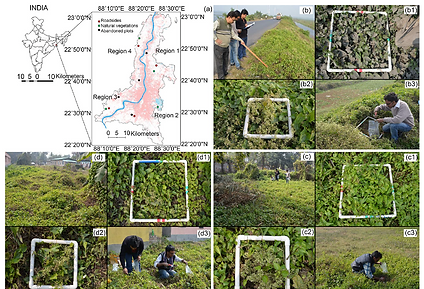
PhD work
Thesis abstract
Investigations on the invasiveness of Mikania micrantha Kunth (Asteraceae) with respect to its spread and distribution in Greater Kolkata
Plant invasions are considered to be one of the major threats to biodiversity. Mikania micrantha Kunth of Latin American origin, considered to be one of the top invaders in moist tropical zones of Asia-Pacific, has been widely studied though mostly in forest and plantation areas. This thesis attempts to highlight the ability of M. micrantha to overcome the barriers of the invasion process with special reference to its encroachment in urban areas together with trying to understand its pathway of introduction, the rate of spread, and the status of present distribution both within the Greater Kolkata region as well as for the entire country.
The first evidence of multiple introductions of M. micrantha into India with documentary evidence of Calcutta being the region of first introduction could be ascertained from this study. A baseline data created for the study area shows that the plant is mostly restricted to small patches. A follow-up survey revealed an increase in the number of small patches within a two-year period denoting quick spread. Anthropogenic activities and expanding transport networks within the city appear to a contributing factors to the spread into new areas. Experimental evidence revealed the strategic adaptability of M. micrantha to seasonal changes as well as to different types of disturbances prevalent in urban areas by modulating its fitness-related traits. The plant could modulate its growth around its carrying capacity thereby maintaining a high vegetative relative growth rate (RGR) and also producing lightweight seeds with extended viability. M. micrantha appeared to be a “passenger” of change taking advantage of disturbance in urban habitats which native species are unable to cope with. Regular monitoring together with the ‘early detection and rapid response’ approach in urban fragmented landscapes may be the most pertinent control option to prevent further spread. However, if growth is left unchecked, M. micrantha may become the community dominant or “driver” of change by competing with the resident species. The niche modeling approach suggests that the plant is still spreading within the country and revealed additional areas to be climatically suitable probably due to niche and biome inconsistencies of the plant.
Chapters
Introduction pathway reconstructed (published)
-
Based on archival botanical records and herbarium data.
-
Evidence in support of multiple introductions was found.
-
The plant was introduced into India from multiple places in Latin America to multiple locations and multiple times by multiple routes.
-
The first introduction was probably into Calcutta via the Calcutta Botanical Garden during the late 19th century, followed by its introduction into northeast India and finally into the southwest part of the country.


Distribution in a city mapped (published)
-
Using remote sensing and GIS technologies.
-
Image classification - land use and land cover.
-
Soil sample analysis.
-
A field survey was conducted following a proper sampling design.
-
Small populations were restricted to the ‘built up’ land use class within the city, and along minor roads, whereas most of the large infestations occurred in the ‘sparse vegetation’ land use class and along major roads.
Survival ability investigated (published)
-
In terms of its fitness (abundance and biomass) and phenotypic plasticity of selected fitness-related traits.
-
Quadrat-based study.
-
Soil sample analysis.
-
Seasonal (summer, monsoon, and winter) and habitat (littoral, transitional terrestrial, and terrestrial) influence on the survival ability.
-
Three habitats (roadsides, natural areas, and abandoned plots), representative of the disturbances prevalent in the study area, were studied to assess the effect of disturbance on trait plasticity.


Vegetative growth dynamics mapped
-
Regeneration experiments in winter and monsoon
-
Quadrat-based study
-
To compare the relative growth rate and carrying capacity in terms of vegetative biomass.
-
The logistic growth model was the best fit to explain the growth dynamics of this plant.
-
In winter, the undisturbed site favored growth. The slow but steady RGR in the disturbed habitat helped to maintain its biomass and outcompete the native vegetation.
-
During the monsoons, it exhibited a higher growth rate and maintained maximum carrying capacity in the population.
Plasticity in sexual traits found
-
Addressed both at a temporal and spatial scale
-
Quadrat-based study at weekly intervals
-
Record the flowering phenology, and seed viability after storing the seeds for specified periods of time
-
The effect of disturbance on seed germination was also studied similarly across different sites.
-
Temperature influenced the flowering phenology and production of viable seeds. The seeds could remain viable for 90 days.
-
Lighter seeds were produced in roadside populations while the most efficient germination and viability retention were observed for those disturbed sites.


Role in community decoded (published)
-
Community composition in terms of species associations, diversity indices, and the native and exotic relationship.
-
Based on field survey data
-
Most sites had more than one non-native species.
-
M. micrantha was the community-dominant which could be considered to be a ‘passenger’ of habitat alteration that suppressed native species, but was likely to become a ‘driver’ once it attained high covers due to its reported superior competitive abilities.
Spatial and temporal spread detected (published)
-
New satellite populations were found in nearly 50% of the sites that had no M. micrantha population 2 years ago.
-
Using the location data gathered from herbarium sheets as well as from literature records from the time since its introduction into India, invasion curves were constructed. The rate of spread was found to be significantly higher with the shortest lag period in southwest India.
-
A potential distribution map was generated using the Maximum Entropy Species Distribution Model. In addition to the reported presence of the plant in the northeast and southwest parts of the country, the model identified new areas to be climatically suitable










